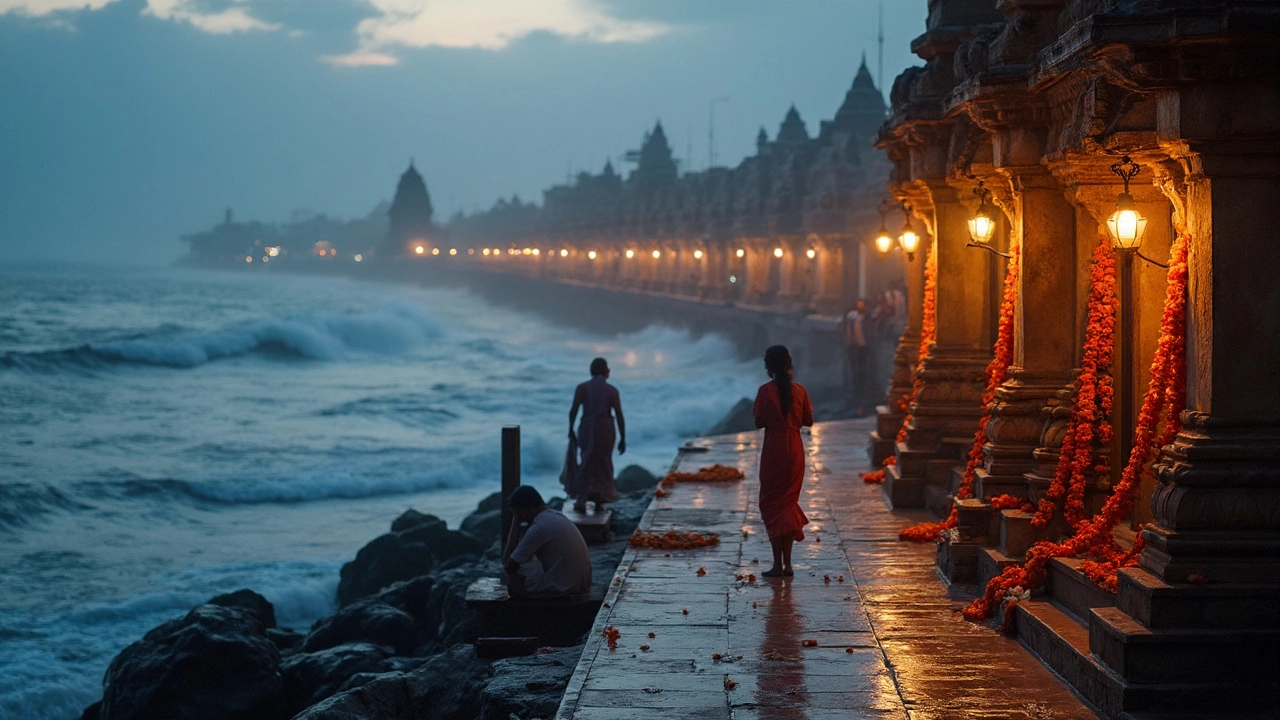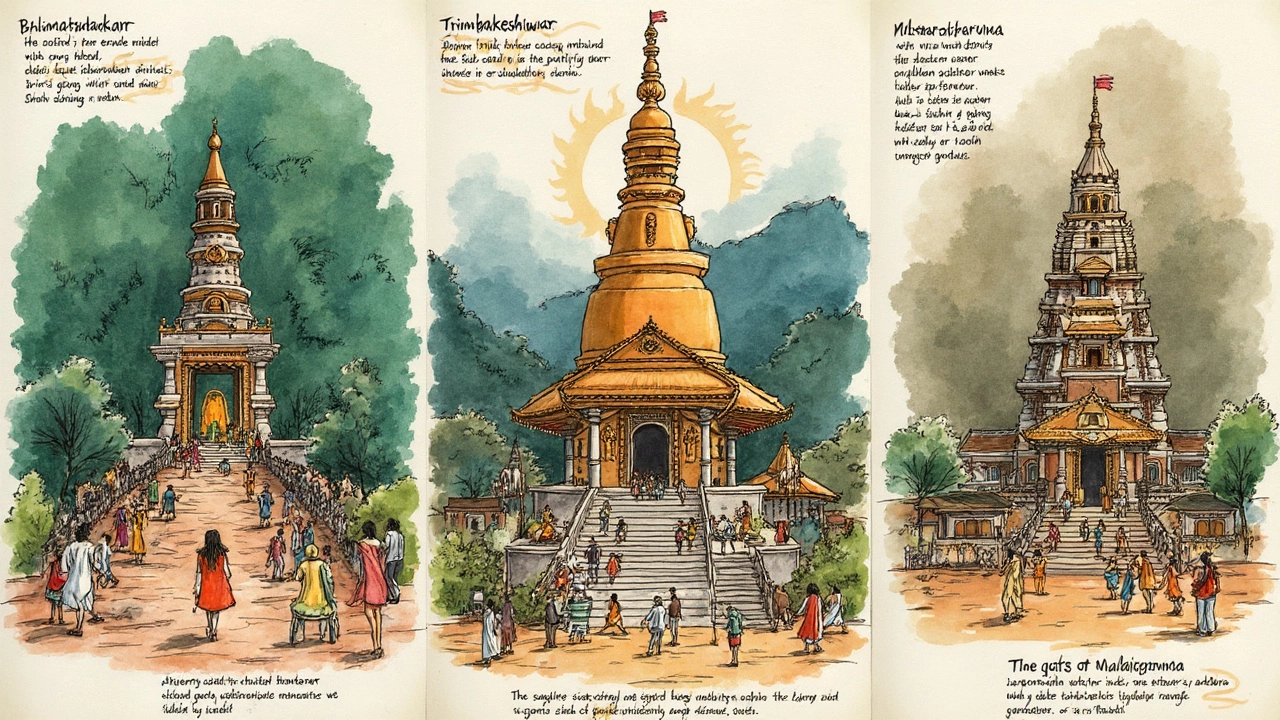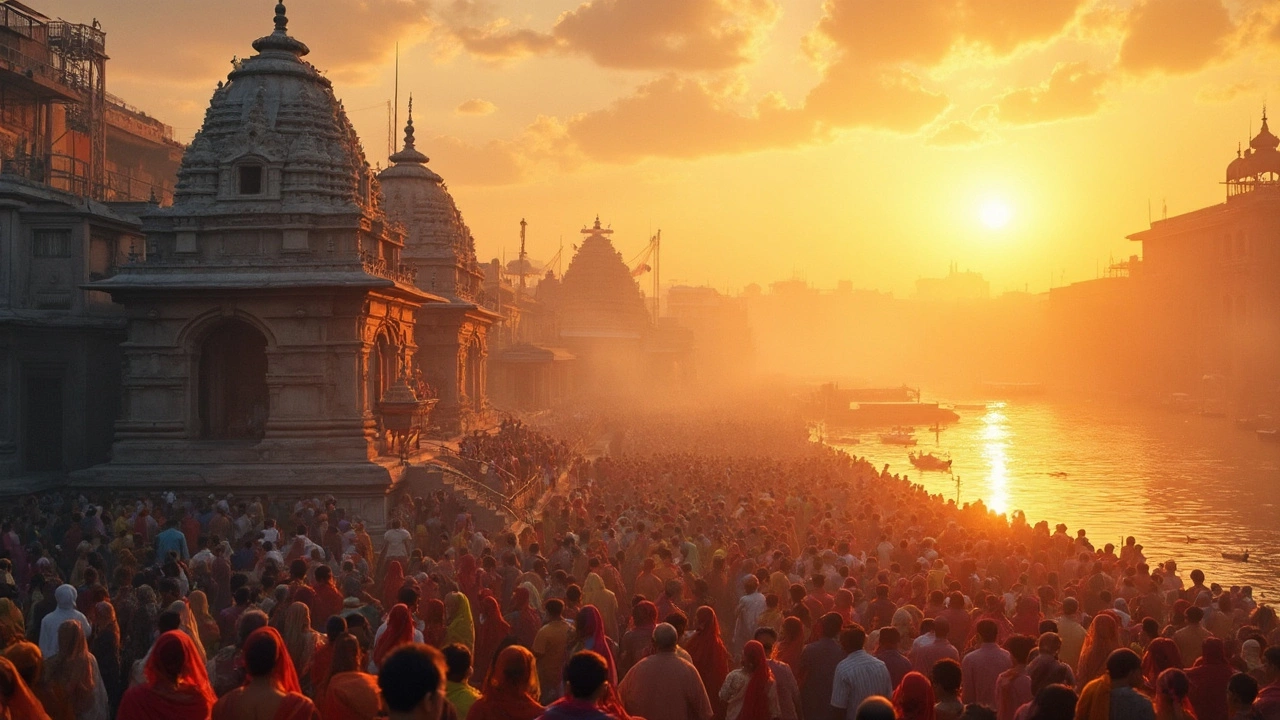Ask around in any Indian temple town and you’ll get different answers about which Jyotirlinga is the most powerful. Some say Kashi Vishwanath, others swear by Somnath. There’s even heated debate in family WhatsApp groups—trust me, my uncle is still campaigning for Kedarnath. So what’s the truth?
First, there’s no official ranking—no committee is handing out power trophies. Each of the twelve Jyotirlingas has its own special story, vibe, and crowd of dedicated followers. People feel strong connections for all sorts of reasons, like personal miracles, family traditions, or even just that unforgettable energy you get when you stand in a particular sanctum.
If you’re planning a temple tour, knowing how people perceive each Jyotirlinga actually helps you narrow down where you want to go. It’s not just about ticking boxes—some temples feel peaceful and meditative, others are noisy and bustling but alive with energy. Let’s break down how these ancient shrines really compare, and how to make your trip smooth, meaningful, and maybe even life-changing.
- What Are Jyotirlingas—And Why Do They Matter?
- Power Ranking: How Devotees View Each Jyotirlinga
- Stories, Legends, and Real Experiences
- Planning Your Visit: Practical Tips for Pilgrims
- Choosing Your Jyotirlinga: What Matters Most for You?
What Are Jyotirlingas—And Why Do They Matter?
Let’s get the basics straight. Jyotirlingas are twelve special shrines across India, dedicated to Lord Shiva. The word comes from Sanskrit: ‘jyoti’ means light, and ‘linga’ means mark or sign. According to Hindu legends, these shrines aren’t regular temples—they’re believed to be places where Shiva himself showed up as a fiery column of light. That’s why these temples get so much attention year after year.
Visiting a Jyotirlinga isn’t just a ritual for the super religious. People of all ages make the trip, hoping for blessings, health, or even peace of mind. Each Jyotirlinga has its own unique story. For example, Somnath in Gujarat is said to have survived multiple invasions, and Kashi Vishwanath in Varanasi is central to the city’s almost endless religious festivals.
But why do they matter so much? For many, visiting a Jyotirlinga means connecting with tradition—or simply experiencing the energy and bustle that you can only find in these ancient places. Hindus believe a visit can wipe out past regrets and set you on a good path moving forward.
Here’s a quick look at the locations and special notes for each Jyotirlinga:
| Name | State | Major Festival |
|---|---|---|
| Somnath | Gujarat | Maha Shivratri |
| Kashi Vishwanath | Uttar Pradesh | Dev Deepawali |
| Kedarnath | Uttarakhand | Opening Day (May) |
| Mahakaleshwar | Madhya Pradesh | Mahashivratri |
| Trimbakeshwar | Maharashtra | Kumbh Mela |
| Bhimashankar | Maharashtra | Mahashivratri |
| Mallikarjuna | Andhra Pradesh | Brahmotsavam |
| Omkareshwar | Madhya Pradesh | Mahashivratri |
| Vaidyanath | Jharkhand | Shrawan Mela |
| Nageshwar | Gujarat | Mahashivratri |
| Ramanathaswamy | Tamil Nadu | Mahashivratri |
| Grishneshwar | Maharashtra | Mahashivratri |
Planning to visit one? You’ll notice that each place feels different. Some are way up in the mountains, like Kedarnath, while others are right in the middle of city chaos. Each site attracts thousands—sometimes millions—during festivals or special rituals.
People often ask, “Which Jyotirlinga is most powerful?” The answer usually depends on personal experience. But it’s clear: every one of these shrines holds a deep place in India’s spiritual heart.
Power Ranking: How Devotees View Each Jyotirlinga
No official scoreboard exists for the most powerful Jyotirlinga, but ask any devotee and you’ll hear strong opinions. Each shrine has its own crowd of loyal fans, and not always for the reasons you’d expect. The vibe at every Jyotirlinga is different, and people often pick favorites based on personal experiences rather than ancient scriptures.
Let’s talk real numbers and popularity first. If you go by sheer crowd size, Kashi Vishwanath in Varanasi and Somnath in Gujarat win by a mile. Kashi pulls in about 3 million pilgrims every year, especially during Shivratri when the place is buzzing. Somnath isn’t far behind, with festivals and daily darshan drawing thousands.
| Jyotirlinga | Location | Annual Footfall (Approx.) | Highlights |
|---|---|---|---|
| Kashi Vishwanath | Varanasi, Uttar Pradesh | 3 million+ | Famous for spiritual energy, never closes doors for devotees |
| Somnath | Prabhas Patan, Gujarat | 2 million+ | Historic, rebuilt over centuries, strong legend of resilience |
| Kedarnath | Uttarakhand | Over 1 million during open season | Sits high in the Himalayas, trek needed, raw and remote |
| Mahakaleshwar | Ujjain, Madhya Pradesh | 1 million+ | Unique Bhasma Aarti at dawn, only Jyotirlinga facing south |
| Trimbakeshwar | Nashik, Maharashtra | 800,000+ | Known for its special Hindu rituals and river origin |
Some devotees swear by mythological importance. For them, Kedarnath’s location high in the Himalayas makes it ‘the’ place for powerful vibrations, especially after that huge flood in 2013, when the temple barely survived. People say just reaching there is half the spiritual experience. Then you’ve got Somnath, known for withstanding invasions and still standing strong—folks see that as a sign of divine strength.
Personal miracles and family traditions play a part, too. My friend’s family never misses Mahakaleshwar’s early morning Bhasma Aarti, claiming they feel a unique energy there you won’t get anywhere else. Others, especially new visitors, go by online buzz—Kashi takes the crown when you check YouTube vlogs and Google reviews.
- If you want peaceful vibes, try Bhimashankar (near Pune) or Grishneshwar (near Ellora Caves).
- If you need adrenaline and a hiking challenge, aim for Kedarnath.
- If you’re going for ritual significance, Trimbakeshwar is a winner for those into Hindu rites of passage.
The truth? The most powerful Jyotirlinga really depends on what you’re searching for—spiritual energy, adventure, healing, tradition, or just a big crowd to blend into. Nobody agrees on one answer, and that's what keeps pilgrims coming back year after year, hoping to discover their own favorite.

Stories, Legends, and Real Experiences
Every Jyotirlinga comes with a unique story that’s stuck with devotees for centuries. For example, the Jyotirlinga at Somnath is known as the place where the moon god prayed to Shiva to get rid of a curse. Most guides and temple priests will happily tell you how this temple was destroyed and rebuilt multiple times—locals see this as proof of its undying strength. People say the vibes here feel stubborn and hopeful at once.
Kedarnath has a reputation for both the wild Himalayan setting and the legend of Shiva hiding from the Pandavas. Claire and I visited this spot a few years back, and honestly, nearly every pilgrim we met had a personal story—someone found peace after a rough divorce, others felt a strange clarity just by sitting in the cold shadow of the temple. Even the guides talked about a huge number of near-miss stories during floods, calling it "almost like Shiva puts a shield up."
Kashi Vishwanath is famous for the story that says if you die here, Shiva himself whispers salvation in your ear. This makes it a pilgrimage magnet for those wanting a spiritual insurance policy. It’s also the only Jyotirlinga where you’ll see a mix of regular worshippers, backpackers, and the occasional IT guy taking a remote call on temple steps. No joke, last year, I saw a bunch of locals organize a midnight aarti just for a sick relative—it felt raw, emotional, and very real.
- Somnath: Resilience—destroyed and rebuilt 16 times.
- Kedarnath: Survival—the 2013 floods didn’t harm the inner sanctum.
- Kashi Vishwanath: Liberation—believed to guarantee moksha for those who die nearby.
- Trimbakeshwar: Birthplace of the Godavari river, known for peaceful rituals and family ceremonies.
- Bhimasankar: Remote jungle, attracts trekkers and solitude seekers. Locals talk about hearing chants echo off the hills early in the morning—goosebumps every single time.
When it comes to picking which shrine to visit, people often trust word-of-mouth over ancient texts. A man I met at Bhimasankar swears his chronic cough vanished after visiting. My cousin believes her business turned around after a trip to Trimbakeshwar. Whether or not you buy these stories, the truth is the lines between legend and real experience blur pretty quickly at these places. Sometimes, all it takes is a moment—or a conversation over tea with other pilgrims—to feel why a single temple means so much to people.
Planning Your Visit: Practical Tips for Pilgrims
If you’re thinking about visiting a Jyotirlinga, there’s more to it than just showing up. These places pull crowds, so a little planning can make your trip way smoother—especially if it’s your first big temple tour.
Start with the basics: check travel options to your chosen shrine. Some Jyotirlingas like Kashi Vishwanath are in the middle of bustling cities, so grabbing a cab or rickshaw is easy. Others, like Kedarnath, involve serious trekking—think about altitude and fitness! For shrines in remote parts, trains get you close, but you might need to book a local jeep for the last stretch.
- Most powerful Jyotirlinga or not, some temples get insanely busy during festivals—especially Mahashivratri and Shravan month. If crowds aren’t your thing, aim for off-peak months right after the main season winds down.
- Book darshan tickets online if the temple offers it. Places like Somnath and Trimbakeshwar have digital queues or VIP options—saves a ton of time.
- For Kedarnath and Bhimashankar, pack light but don’t skip layers if you’re visiting between October and March. Nighttime temperatures drop hard. Comfortable shoes are a must for any temple with a climb or long walking stretch.
- Watch out for temple timings. Some shrines close for a few hours midday, and early mornings are usually quieter and more peaceful.
- Keep an eye on local rules—certain temples require specific dress codes or don’t allow cameras/phones inside. It’s worth checking the temple’s official site or recent reviews before you go so you’re not caught off guard.
Here’s a quick look at travel distances and climate for a few famous Jyotirlingas:
| Jyotirlinga | Nearest City | How to Reach | Best Time to Visit |
|---|---|---|---|
| Kashi Vishwanath | Varanasi | Auto/cab straight to temple; walking in old city | October-March |
| Kedarnath | Rishikesh/Haridwar | Train/jeep, then 16 km trek | May-June, September-October |
| Somnath | Veraval | Train or cab; walk from parking | November-March |
| Trimbakeshwar | Nashik | Taxi or bus; short walk | September-February |
Don’t underestimate how much local food and rest can affect your trip. I learned this the hard way after skipping breakfast at Trimbakeshwar—big mistake. Hydrate, try the local thali when you can, and give yourself time to just sit and soak up the energy. Sometimes those quiet minutes beat any elaborate ritual.

Choosing Your Jyotirlinga: What Matters Most for You?
Everyone wants to visit the most powerful Jyotirlinga, but there’s no one-size-fits-all solution. Your best choice depends on what you’re looking for—spiritual vibes, scenic spots, easy access, or even family traditions. Let’s break down what really matters.
If you’re all about raw spiritual energy, consider Kashi Vishwanath in Varanasi. Locals will tell you the city itself feels like another world, and the temple is always packed with pilgrims. But with big crowds come long waits and a “blink and you’ll miss it” darshan, unless you plan ahead or know the ropes.
Prefer something quieter? Go for Bhimashankar in Maharashtra. It’s surrounded by forest, and the trek there adds to the spiritual experience. Less commercial, more calm. Or try Baidyanath in Jharkhand, a favorite for devotees seeking relief from chronic illnesses—people genuinely believe in its healing powers.
Travel logistics matter too. Some shrines—like Somnath and Trimbakeshwar—are super accessible by train, road, or even flights. Kedarnath, on the other hand, is a challenging trek in the Himalayas. It’s not just about faith there—it’s your endurance that gets tested.
Here’s a quick way to zero in on your ideal Jyotirlinga:
- For a lively vibe: Kashi Vishwanath or Somnath
- For peace and nature: Bhimashankar or Omkareshwar
- For healing and wellness prayers: Baidyanath
- For epic adventure: Kedarnath
If you’re visiting with elders or those who find travel tough, stick to ones with easy transport and good facilities—like Trimbakeshwar near Nashik or Mahakaleshwar in Ujjain. These also have nearby hotels and food options, and you won’t be scrambling for basics.
Ask your family or close friends if they have any connection to a particular Jyotirlinga. That alone can make your visit extra meaningful. And remember, no travel agent or influencer can choose for you—the right temple is the one that calls to you, for whatever reason makes sense to you at this point in life.
So what matters most? Simple—what you want from this journey. Power isn’t just about the legend or the crowd. It’s about what feels right for you.
